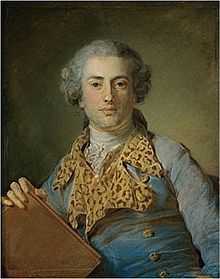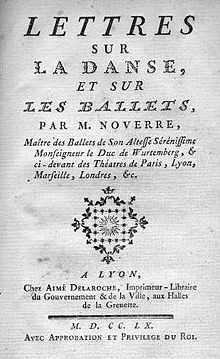Jean-Georges Noverre

(Perronneau, 1764, Louvre)
Jean-Georges Noverre (29 April 1727 – 19 October 1810) was a French dancer and balletmaster, and is generally considered the creator of ballet d'action, a precursor of the narrative ballets of the 19th century. His birthday is now observed as International Dance Day.
His first professional appearances occurred as a youth in Paris at the Opéra-Comique, at Fontainebleau, in Berlin before Frederick II and his brother Prince Henry of Prussia, in Dresden and Strasburg. In 1747 he moved to Strasbourg where he remained until 1750 before moving to Lyon. In 1751, he composed his first great work, Les Fêtes Chinoises for Marseilles. The work was revived in Paris in 1754 to great acclaim. In 1755, he was invited by Garrick to London, where he remained for two years.
Between 1758 and 1760 he produced several ballets at Lyon, and published his Lettres sur la danse et les ballets (fr). It is from this period that the revolution in the art of the ballet for which Noverre was responsible can be dated. He was next engaged by Duke Karl Eugen of Württemberg, and later Austrian Empress Maria Theresa, until 1774. In 1775, he was appointed maître des ballets of the Paris Opera at the request of Queen Marie Antoinette. He returned to Vienna in Spring of 1776 to stage ballets there but in June 1776 he returned again to Paris. He regained this post until the French Revolution reduced him to poverty. He died on 19 October 1810 at Saint-Germain-en-Laye.
Noverre's friends included Voltaire, Mozart, Frederick the Great and David Garrick (who called him "the Shakespeare of the dance"). The ballets of which he was most proud were his La Toilette de Venus, Les Jalousies du sérail, La dour corsaire and Le Jaloux sans rival. Besides the letters, Noverre wrote Observations sur la construction d'une nouvelle salle de l'Opéra (1781); Lettres sur Garrick écrites a Voltaire (1801); and Lettre à un artiste sur les flies publiques (1801).
Early life and career
Noverre was born in Paris on 29 April 1727 to Marie Anne de la Grange and Jean Louys, a Swiss soldier. The couple expected their son to pursue a military career but the boy chose dance, studying with M. Marcel and then with the famous Louis Dupré. Noverre's first professional experience probably occurred at the Opéra-Comique in Paris on 8 June 1743 in Le Coq du village. In his middle and late teenage years, Noverre performed at Fontainebleau, and in Berlin before Frederick II and his brother Prince Henry of Prussia. Appearances in Dresden and Strasbourg followed before his return to the Opéra-Comique. In 1747, Noverre became ballet master in Strasbourg and created his first great success, the exotic Les Fêtes Chinoises. In 1748 in Strasbourg he married the actress Marie-Louise Sauveur.[1] In 1750, he became principal dancer in Lyon and created his first ballet-pantomime, Le Jugement de Paris. He moved to Strasbourg for one year in 1754, and returned to the Opéra-Comique where Les Fêtes was staged with great success on 1 July 1754.
In 1755, he went to London with his wife, his sister and brother, and his company. There, he worked with David Garrick of the Drury Lane Theatre, learning new concepts of theatre and the then developing natural style of performance. When the London production of Les Fêtes was completely destroyed by rioters on the eve of the Seven Years War, Noverre and his family were forced to go into hiding. He continued to supervise dance spectacles at Drury Lane but without billing. He left London in 1757 wanting to work at the Paris Opéra but realized he would face serious opposition to the expressive style he had developed in London, and chose Lyon instead where he was free to develop new and very different works from the prevailing court ballets. He composed Les Caprices de Galathée, for example, and garbed his dancers in tiger skins and shoes made of tree bark. His naturalist attitude towards costume placed him in the front rank of the French Enlightenment.[2]
Les Lettres sur la danse et sur les ballets
Context
Noverre's treatise on dancing and theater expressed his aesthetic theories on the production of ballets and his method of teaching ballet. Noverre wrote this text in London in 1756 and published it in 1760 in Lyon, France. He began his research for his essays in Drury Lane, London where he choreographed for his own troupe of dancers at the Theater Royal under the direction of David Garrick. It was in David Garrick’s library that Noverre read modern French literature and ancient Latin treatises on pantomime. Noverre was inspired by the pantomimes that he thought stirred up the audience's emotions by the use of expressive movement. He proclaimed in his text that ballet should unfold through dramatic movement and the movement should express the relationship between the characters. Noverre named this type of ballet, ballet d’action or pantomime ballet and produced his first serious pantomime ballet. called Le Jugement de Paris. in 1751 in Marseilles (International Dictionary of Ballet 1032).
Inspiration
Noverre was most immediately influenced by Jean-Philippe Rameau, Marie Sallé and David Garrick. Rameau was a very influential French composer and music theorist and Noverre was inspired by his dance music that combined programmatic and strongly individual elements. Marie Salle and Noverre were both dance students at the Paris Opera Ballet and met early on in their careers. Marie Salle, a Romantic ballerina with expressive qualities, likely influenced Noverre to write about the importance of expression in dance. David Garrick was an actor and theater director at the Theater Royal. Noverre was inspired by his talent for "histrionics."(The Encyclopedia of Dance and Ballet 695).
Content
Noverre's text demanded an end to repressive traditions peculiar to the Paris Opera Ballet, such as stereotypical and cumbersome costumes, and old-fashioned musical styles and choreography. Noverre also discussed the methods for training dancers such as encouraging a student to capitalize on his or her own talents (The Encyclopedia of Dance and Ballet 699). Most of Noverre's criticisms of dance in his book were directed towards the Paris Opera Ballet[3] because he felt the Paris Opera Ballet created ballets that were an isolated event within Opera lacking meaningful connection with the main theme of the Opera. He criticized the Paris Opera Ballet[4] use of the mask because it restricted the dancer from showing facial expressions that could bear meaning on their characters. Noverre devoted the whole of his Ninth Letter to the subject of masks and wrote, " Destroy the masks and" he argued, "we shall gain a soul, and be the best dancers in the world." Noverre specifically dealt with seven major points in his treatise:
- Regarding the training of dancers, he emphasized that correctness in dance technique as laid down by Pierre Beauchamp and others must be held with sensitivity to the individual's anatomy.
- Of Prime concern, the pedagogical consideration of the dancer's personality and style is prerequisite to artistic development.
- Noverre stressed that within a dramatic context, validity and sincerity of gestural expression are of the utmost importance in creating a ballet.
- Noverre called for the logical development of plots. According to Noverre, plots should be thematically integrated with movement. Additionally, all superfluous solos and irrelevant dance techniques should be omitted from the ballet.
- Noverre was adamant that music be appropriately suited to the dramatic development of the plot.
- He insisted that costumes, décor, and lighting be compatible with the introduction, plot, and climax of each act within the ballet.
- With the disappearance of masks in his own ballets, Noverre pronounced his advanced ideas on stage make-up for dancers that would allow for the dancer's expression to be seen rather than hidden behind a mask (Lee 111).
Impact
Noverre's Les Lettres sur la danse et sur les ballets had lasting impact on ballet ideology as his text has been printed in almost every European Language and his name is one the most frequently quoted in the literature of dance (Lynham 13). Many of his theories have been implemented in dance classes today and remain a part today's ideology of dance. For example, his idea that a teacher should encourage students to profit from his or her own talents rather than to imitate a teacher or the style of a popular dancer is a present ideology of dance. Noverre did receive criticism from many of his prominent ballet contemporaries, however his theories have survived longer than any of his ballets, which have not been reproduced for at least two centuries (Lynham 127).
Major works

- Les Fêtes Chinoises (Paris 1754) (mus. Jean-Philippe Rameau)
- La Fontaine de jouvence (Paris 1754)
- La Toilette de Vénus (Lyon 1757) (mus. François Granet)
- L'Impromptu du sentiment (Lyon 1758)
- La Mort d'Ajax (Lyon 1758) (mus. François Granet)
- Alceste (Stuttgart 1761 - Wien 1767) (mus. Christoph Willibald Gluck)
- La Mort d'Hercule (Stuttgart 1762)
- Psyché et l'Amour (Stuttgart 1762) (mus. Jean-Joseph Rodolphe)
- Jason et Médée (Stuttgart 1763 - Wien 1767 - Paris 1776 e 1780 - London 1781) (mus. Jean-Joseph Rodolphe)
- Hypermnestre (Stuttgart 1764)
- Diane et Endymion (Wien 1770)
- Le Judgement de Pâris (Wien 1771)
- Roger et Bradamante (Wien 1771)
- Agamemnon vengé (Wien 1772)
- Iphigénie en Tauride (Wien 1772) (mus. Christoph Willibald Gluck)
- Thésée (Wien 1772)
- Acis et Galathée (Wien 1773)
- Adèle de Ponthieu (Wien 1773 - London 1782)
- Alexandre et Campaspe de Larisse (Wien 1773)
- Les Horaces et les Curiaces (Wien 1774 - Paris 1777)
- Renaud et Armide (Milan 1775 - London 1782)
- Apelle et Campaspe (Paris 1776 - Lyon 1787)
- Les Caprices de Galatée (Paris 1776 - London 1789)
- Annette et Lubin (Paris 1778)
- Les Petits Riens (Paris 1778) (mus. Wolfgang Amadeus Mozart e al.)
- Les Amours d'Énée et de Didon (Lyon 1781)
- La Fête du Sérail (Paris 1788)
- L'Amour et Psyché (London 1788) (mus. Jean-Joseph Rodolphe)
- La Fête de Tempé (London 1788)
- Admète (London 1789)
- La Bergère des Alpes (London 1794)
- La Vittoria (London 1794)
- Windsor Castle (London 1795)
See also
References
- Footnotes
- ↑ Michael Lorenz: "»Mademoiselle Jeunehomme« Zur Lösung eines Mozart-Rätsels", Mozart Experiment Aufklärung. Essays for the Mozart Exhibition 2006, (Ostfildern: Hatje Cantz Verlag, Da Ponte-Institut, 2006), 423-29.
- ↑ Kant 2007, pp. 87–89
- ↑ http://www.parisoperaballet.com.au/site/gala.html
- ↑ http://www.parisoperaballet.com.au/site/gala.html
- Bibliography
- Guest, Ivor (2006). The Paris Opera Ballet. Alton, Hamshire: Dance Books.
- Kant, Marion (2007). The Cambridge Book of Ballet. Cambridge and New York: Cambridge University Press.
- Lee, Carol (2002). Ballet in Western Culture: A History of its Origins and Evolution. Great Britain: Routledge.
- Lynham, Deryck (1950). The Chevalier Noverre, Father of Modern Ballet; a biography. New York: British Book Center.
- Noverre, Jean-George (2004). Letters on Dancing and Ballet. Alton: Dance Books.
- "Jean-Georges Noverre". The Encyclopedia of Dance and Ballet. 1977.
- "Jean-George Noverre". International Dictionary of Ballet. 1993.
-
 This article incorporates text from a publication now in the public domain: Chisholm, Hugh, ed. (1911). Encyclopædia Britannica (11th ed.). Cambridge University Press
This article incorporates text from a publication now in the public domain: Chisholm, Hugh, ed. (1911). Encyclopædia Britannica (11th ed.). Cambridge University Press
|
| ||||||||||||||||||||||||||||

